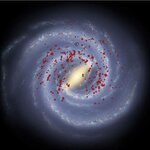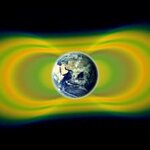Space

If you were a weather forecaster for exoplanet GJ 1214b you would have an easy job. Today's forecast: cloudy. Tomorrow: cloudy. Extended outlook: more clouds.
Determining the weather on a distant planet around another star hasn't really been possible before.
GJ 1214b is classified as a super-Earth type planet because its mass is intermediate between those of Earth and Neptune. Super-Earths like GJ 1214b are among the most common type of planets in the Milky Way galaxy but because no such planets exist in our Solar System, the physical nature of super-Earths is largely unknown.
Previous…

Solar variation has not strongly influenced climate change, according to a paper which seeks to overturn a widely held scientific view that lengthy periods of warm and cold weather in the past might have been caused by periodic fluctuations in solar activity.
Research in a narrow time period - the last 1,000 years - examined the causes of climate change in the northern hemisphere and found that until the year 1800, the key driver of periodic changes in climate was volcanic eruptions. These tend to prevent sunlight from reaching the Earth, causing cool, drier weather. Since 1900,…

A new population of exploding stars must 'switch off' their radio transmissions before collapsing into a Black Hole. But they emit one last strong beam of highly energetic radiation, known as a gamma-ray burst, before they die.
It was thought all gamma-ray bursts were followed by a radio afterglow.
"But we were wrong. After studying an ultra-sensitive image of gamma-ray bursts with no afterglow, we can now say the theory was incorrect and our telescopes have not failed us," Centre for All-sky Astrophysics (CAASTRO) at Curtin University research fellow Dr. Paul Hancock said.
The technique they…

For most of its life, a star is pretty stable, slowly consuming the fuel at its core to keep it shining brightly, but once most of the hydrogen that stars use as fuel has been consumed, some stars evolve into very different beasts -- pulsating stars. They become unstable, expanding and shrinking over a number of days or weeks and growing brighter and dimmer as they do so.
A new Hubble image over five weeks shows RS Puppis, a type of variable star known as a Cepheid variable. As variable stars go, Cepheids have comparatively long periods. RS Puppis, for example, varies in brightness by almost…

It's not well known but astronomers actually cannot see what our Galaxy, the Milky Way, really looks like. We are on the inside looking out so scientists instead deduce its shape by observation of its stars and their distances from us.
In the 1950s, astronomers used radio telescopes to map our Galaxy. Their observations focused on clouds of gas in the Milky Way in which new stars are born, revealing four major arms. More recently, NASA's Spitzer Space Telescope scoured the Galaxy for infrared light emitted by stars but in 2008 it was announced that Spitzer imaging had found about 110…

Astronomers recently took precise measurements of the closest pair of failed stars to the Sun, the binary brown dwarf system WISE J104915.57-531906.1, and the results suggest that the system harbors a third, planetary-mass object.
Failed stars are known as brown dwarfs and have a mass below 8% of the mass of the Sun—not massive enough to burn hydrogen in their centers. This particular system, Luhman 16AB, was discovered earlier this year and is only 6.6 light-years away.
After the discovery announcement, several teams of astronomers used a variety of telescopes to characterize the…

Astronomers have discovered huge active plumes containing water vapour being released from the surface of Jupiter's moon Europa.
Jupiter's moon Europa has been a focus of extraterrestrial research for some time now as there were clear indications that it harbors a liquid ocean beneath its icy crust. Lorenz Roth of the Southwest Research Institute in San Antonio, Texas and Joachim Saur of the University of Cologne have used the NASA/ESA Hubble Space Telescope to prove that there is water vapor erupting near its south pole.
The water plumes are in comparison to earth geysers immensely…

This is an interesting question I was asked recently on the space show. It's inspired by this 5 note theme from the 1970s movie.
(if you don't see videos in this page, try reloading it).
It's the theme tune from Close Encounters of the Third Kind (composed by John Williams), of course, the music the extraterrestrials use to communicate with humans in the movie. Is that just a rather fun movie idea? Or was the director Spielberg on to something, might we be able to communicate with ETs perhaps more readily in music than in other ways?
You can hear the question itself here, in the…

Whether human beings and extraterrestrials could communicate with each other using music. This is a question I was asked on the space show. It was inspired by the 1970s movie with this theme tune: 5 note theme
(if you don't see videos in this page, try reloading it).That of course is from Close Encounters of the Third Kind, and is the music the extraterrestrials used to communicate with humans in the movie.
"Mathematics is a way of communicating with other species from off the planet - but mathematics is also music. Wouldn't it be great if the maths was musical maths, and they started…

Over a year after being launched, NASA's Van Allen Probes mission continues to unravel the mysteries of Earth's high-energy radiation belts that encircle our planet and pose hazards to orbiting satellites and astronauts - termed the Van Allen Radiation Belts.
The Van Allen radiation belts in in the Earth's upper atmosphere were discovered in 1958
and are two doughnut-shaped rings of highly charged particles - an inner ring of high-energy electrons and energetic positive ions, and an outer ring of high-energy electrons. And sometimes a third one.
The newest discovery reveals…